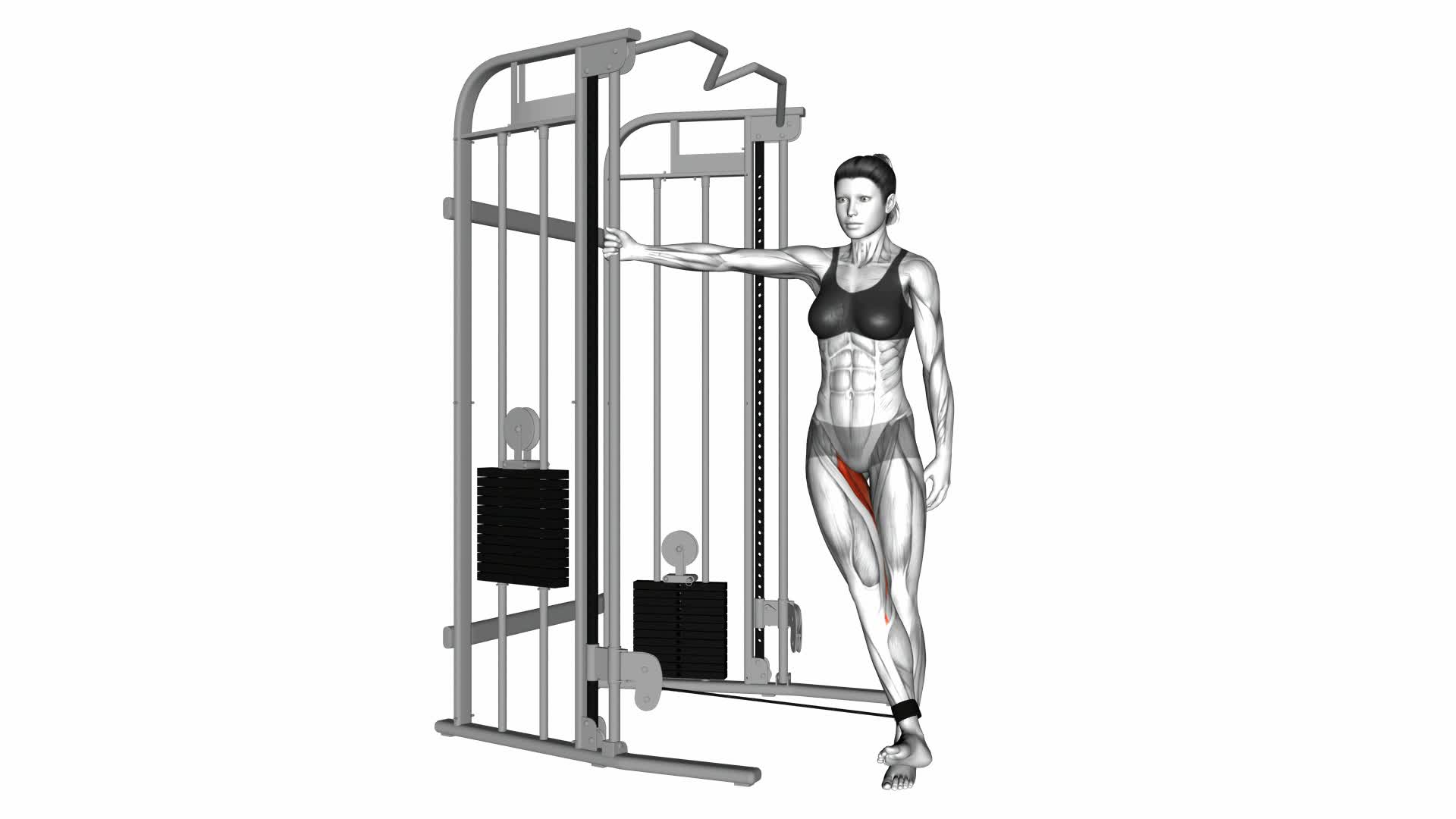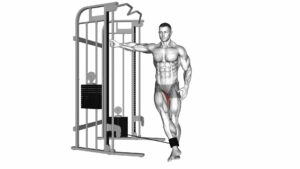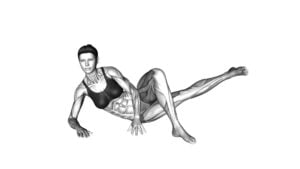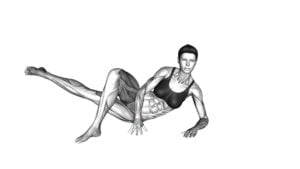Cable Hip Adduction (female) – Video Exercise Guide & Tips

Looking to tone and strengthen your hip muscles? Look no further than cable hip adduction exercises.
Watch This Exercise Video
In this video exercise guide, we'll show you the proper form and technique for this effective workout specifically tailored for females.
Not only will you learn the benefits of cable hip adduction, but we'll also provide tips for increasing intensity and avoiding common mistakes.
Get ready to level up your fitness routine with this expert-approved workout.
Key Takeaways
- Cable hip adduction exercises strengthen and tone the inner thigh muscles, leading to increased muscle definition and improved stability and balance.
- These exercises improve hip stability, reducing the risk of injuries during physical activities and improving posture, alignment, balance, and coordination.
- It is important to maintain proper form and technique during cable hip adduction exercises, including attaching the ankle cuff to the cable machine, standing perpendicular to the machine, and pulling the working leg across the body towards the machine.
- Gradually increasing resistance or weight, listening to your body, and avoiding common mistakes such as incorrect form and excessive weight are crucial for a safe and effective cable hip adduction workout routine.
Importance of Hip Adduction Exercises
Hip adduction exercises are essential for strengthening the inner thigh muscles and improving overall lower body stability and function. These exercises provide numerous benefits to your body, making them a valuable addition to any workout routine.
One of the key benefits of hip adduction exercises is the strengthening of the inner thigh muscles, also known as the adductors. These muscles play a crucial role in stabilizing the hips and pelvis, especially during activities that involve lateral movements, such as running, jumping, and changing directions. By strengthening the adductors, you can improve your overall lower body stability, which can help prevent injuries and enhance your performance in sports and everyday activities.
Furthermore, hip adduction exercises offer variations that target different areas of the inner thigh muscles. For example, you can perform exercises using machines, resistance bands, or bodyweight to create different levels of resistance and challenge. By incorporating different variations into your routine, you can effectively target specific areas of the adductors and ensure balanced muscle development.
In conclusion, hip adduction exercises are crucial for strengthening the inner thigh muscles, improving lower body stability, and enhancing overall function. By incorporating variations of these exercises into your workout routine, you can reap the benefits and achieve a stronger, more stable lower body.
Benefits of Cable Hip Adduction for Females
Are you looking to tone your inner thigh muscles and improve your hip stability? Cable hip adduction exercises are perfect for you!
By using the cable machine, you can target and strengthen the muscles in your inner thighs, helping you achieve a more sculpted and defined look.
Additionally, these exercises also work to improve your hip stability, which is crucial for maintaining proper form and preventing injuries during other exercises or daily activities.
Toned Inner Thigh Muscles
To achieve toned inner thigh muscles, you can benefit from cable hip adduction exercises. These exercises specifically target the muscles in your inner thighs, helping to strengthen and tone them.
Here are some key benefits of incorporating cable hip adduction into your workout routine:
- Increased muscle definition: Cable hip adduction exercises engage the muscles in your inner thighs, helping to sculpt and define them for a more toned appearance.
- Improved stability and balance: By strengthening your inner thigh muscles, you can enhance your overall stability and balance, reducing the risk of injuries during daily activities or other workouts.
- Enhanced lower body strength: Cable hip adduction exercises not only work your inner thighs but also engage other lower body muscles, such as your glutes and hip flexors, leading to improved overall lower body strength.
Improved Hip Stability
Strengthen your inner thigh muscles and improve your hip stability with cable hip adduction exercises.
Hip stability plays a vital role in everyday activities like walking, running, and even sitting. By targeting your inner thigh muscles, the cable hip adduction exercise helps to enhance the stability of your hips, allowing you to move with ease and confidence.
When your hips are stable, you reduce the risk of injuries, such as strains or sprains, that can occur during physical activities. Additionally, strong hip stability can improve your overall posture and alignment, leading to better balance and coordination.
Proper Form and Technique for Cable Hip Adduction
Perform cable hip adduction with proper form and technique to effectively target your hip muscles. This exercise is a great way to improve hip stability and strengthen your inner thighs. Here are some tips to help you perform cable hip adduction correctly:
- Start by attaching an ankle cuff to the cable machine and adjusting the weight to a challenging but manageable level. Stand perpendicular to the machine with your working leg closest to the machine and the other leg slightly behind.
- Engage your core and keep your upper body upright throughout the exercise.
- Slowly pull your working leg across your body towards the machine, keeping your knee straight and your foot flexed.
- Pause for a moment at the end of the movement, feeling a contraction in your inner thigh.
- Return to the starting position in a controlled manner, keeping tension in your hip muscles.
- Repeat for the desired number of repetitions and then switch sides.
By performing cable hip adduction with proper form and technique, you can reap the benefits of increased hip stability and stronger inner thighs.
Don't be afraid to try different variations of this exercise, such as using a resistance band or changing the position of your working leg. Mix it up and keep challenging yourself to see even better results.
Tips for Increasing Intensity and Progression
To maximize the effectiveness of cable hip adduction, gradually increase the resistance or weight used in the exercise. This is known as progressive overload, and it's a key principle in strength training. By increasing the resistance over time, you challenge your muscles to adapt and grow stronger.
When starting cable hip adduction, begin with a weight that allows you to perform the exercise with proper form and technique. As you become comfortable with the movement, gradually increase the resistance. Aim to add a small amount of weight or resistance each week, such as 5-10 pounds. This gradual progression will help prevent injuries and ensure that you continue to make gains in strength.
In addition to increasing resistance, you can also vary the tempo of the exercise to increase intensity. For example, you can perform the movement at a slower pace, focusing on the contraction and squeeze at the top of the movement. This can further challenge your muscles and stimulate growth.
Remember to listen to your body and progress at a pace that's suitable for you. Push yourself, but also respect your limits to avoid overtraining or injury. By gradually increasing the resistance and incorporating progressive overload, you'll continue to see improvements in your cable hip adduction exercise.
Common Mistakes to Avoid During Cable Hip Adduction
When performing cable hip adduction, it's important to be aware of common mistakes that can hinder your progress and even lead to injury.
Incorrect form, such as leaning forward or rounding your back, can put unnecessary strain on your lower back and diminish the effectiveness of the exercise.
Additionally, overloading the weight too quickly without proper muscle activation can also increase the risk of injury.
Paying attention to these common mistakes will help you maximize the benefits of cable hip adduction while minimizing the risks.
Incorrect Form Dangers
Avoiding incorrect form during cable hip adduction is crucial to prevent potential dangers. When performing this exercise, it's important to be aware of the following common mistakes that can lead to potential injuries:
- Using too much weight: Adding excessive resistance to the cable machine can strain your hip joints and muscles, increasing the risk of injury.
- Leaning forward or backward: Maintaining proper alignment is essential. Leaning too far forward or backward can place excessive stress on the lower back and compromise the effectiveness of the exercise.
- Using momentum: Swinging your leg or relying on momentum instead of controlled movements can put unnecessary strain on the hip joint, potentially causing injury.
Overloading Weight Risks
To minimize the risk of overloading weight during cable hip adduction, you should carefully choose a resistance level that challenges you without straining your hip joints and muscles. Overloading weight can lead to potential injuries such as muscle strains, sprains, or even tears. It's crucial to exercise caution and take necessary precautions when performing this exercise.
One common mistake to avoid is selecting a weight that's too heavy for you. If the weight is too much, it can put excessive strain on your hip joints and increase the risk of injury. On the other hand, choosing a weight that's too light may not provide enough resistance to effectively target your hip muscles.
Another mistake to avoid is using improper form or technique. It's important to maintain proper alignment throughout the exercise, keeping your back straight and engaging your core muscles. Avoid leaning or jerking the weight, as this can place unnecessary stress on your hips and increase the risk of injury.
Neglecting Muscle Activation
To ensure proper muscle activation during cable hip adduction, focus on maintaining a strong connection between your hip muscles and the resistance throughout the exercise. Neglecting muscle activation can lead to ineffective workouts and potential injury.
Here are three common mistakes to avoid:
- Allowing momentum to take over: Avoid swinging your leg outward forcefully. This can reduce the engagement of your hip muscles and increase the risk of muscle imbalances.
- Lack of control: Maintain control throughout the entire range of motion. Avoid rushing the movement or using excessive speed, as this can compromise muscle activation.
- Ignoring hip mobility: Adequate hip mobility is essential for proper muscle activation. Prioritize stretching and mobility exercises to improve your range of motion and ensure optimal engagement of the hip muscles.
Sample Cable Hip Adduction Workout Routine
Start by incorporating cable hip adduction exercises into your workout routine for a targeted and effective way to strengthen your hip muscles. Cable hip adduction exercises can be easily modified to suit your fitness level and goals. Here are a few sample cable hip adduction variations you can try:
- Standing Cable Hip Adduction: Stand sideways to the cable machine with the cable attached to your ankle. Slowly bring your leg across your body, towards the midline, against the resistance of the cable. Repeat on both sides.
- Seated Cable Hip Adduction: Sit on a bench facing the cable machine, with the cable attached to your ankle. Bring your leg out to the side against the resistance of the cable, and then bring it back to the starting position. Repeat on both sides.
To incorporate cable hip adduction into full body workouts, you can perform these exercises as part of a lower body or leg day routine. For example, you can start with compound exercises like squats or lunges, and then move on to cable hip adduction exercises to target the hip muscles specifically.
Remember to start with lighter weights and gradually increase the resistance as your strength improves. Aim for 2-3 sets of 10-12 repetitions per exercise. As with any exercise, proper form and technique are crucial to avoid injury and maximize results.
Frequently Asked Questions
How Many Times a Week Should I Perform Cable Hip Adduction Exercises?
To maximize the benefits of cable hip adduction exercises, it's important to find the right frequency. Without considering the specific exercise guide and tips, it's generally recommended to perform these exercises 2-3 times a week.
This gives your muscles enough time to recover and adapt, leading to better results. Remember, consistency is key!
Can Cable Hip Adduction Exercises Help With Reducing Hip Pain or Improving Hip Mobility?
Cable hip adduction exercises can offer great benefits for reducing hip pain and improving hip mobility. By targeting the muscles responsible for hip adduction, these exercises can help strengthen and stabilize your hips, leading to increased range of motion and decreased discomfort.
The cable hip adduction technique involves attaching a cable machine to your ankle and pulling your leg across your body. Incorporating this exercise into your routine can contribute to overall hip health and function.
Are There Any Variations or Modifications of Cable Hip Adduction Exercises for Beginners or Individuals With Limited Range of Motion?
If you're a beginner or have limited range of motion, there are variations and modifications you can try for cable hip adduction exercises. These adjustments can help you ease into the movement and build strength gradually.
Should I Use a Specific Weight or Resistance Level When Performing Cable Hip Adduction Exercises?
When performing cable hip adduction exercises, it's important to use the correct weight or resistance level for optimal results. Using too light of a weight may not provide enough challenge, while using too heavy of a weight could lead to injury.
Can Cable Hip Adduction Exercises Be Beneficial for Individuals Who Are Not Athletes or Fitness Enthusiasts?
Cable hip adduction exercises can definitely benefit individuals who aren't athletes or fitness enthusiasts. These exercises can improve everyday activities by strengthening the hip muscles and increasing stability. Whether you're picking up groceries or playing with your kids, having strong hip muscles can make these activities easier and more enjoyable.
Additionally, cable hip adduction exercises can aid in rehabilitation for individuals with hip injuries, helping them regain strength and mobility in their hips.
Conclusion
In conclusion, cable hip adduction exercises are a fantastic way for females to strengthen and tone their hip muscles. By using proper form and technique, and gradually increasing intensity, you can achieve great results.
Remember to avoid common mistakes and follow a well-designed workout routine to maximize the benefits.
Incorporate cable hip adduction into your fitness routine and start reaping the rewards of a stronger and more toned lower body.

Author
Years ago, the spark of my life’s passion ignited in my mind the moment I stepped into the local gym for the first time. The inaugural bead of perspiration, the initial endeavor, the very first surge of endorphins, and a sense of pride that washed over me post-workout marked the beginning of my deep-seated interest in strength sports, fitness, and sports nutrition. This very curiosity blossomed rapidly into a profound fascination, propelling me to earn a Master’s degree in Physical Education from the Academy of Physical Education in Krakow, followed by a Sports Manager diploma from the Jagiellonian University. My journey of growth led me to gain more specialized qualifications, such as being a certified personal trainer with a focus on sports dietetics, a lifeguard, and an instructor for wellness and corrective gymnastics. Theoretical knowledge paired seamlessly with practical experience, reinforcing my belief that the transformation of individuals under my guidance was also a reflection of my personal growth. This belief holds true even today. Each day, I strive to push the boundaries and explore new realms. These realms gently elevate me to greater heights. The unique combination of passion for my field and the continuous quest for growth fuels my drive to break new ground.







